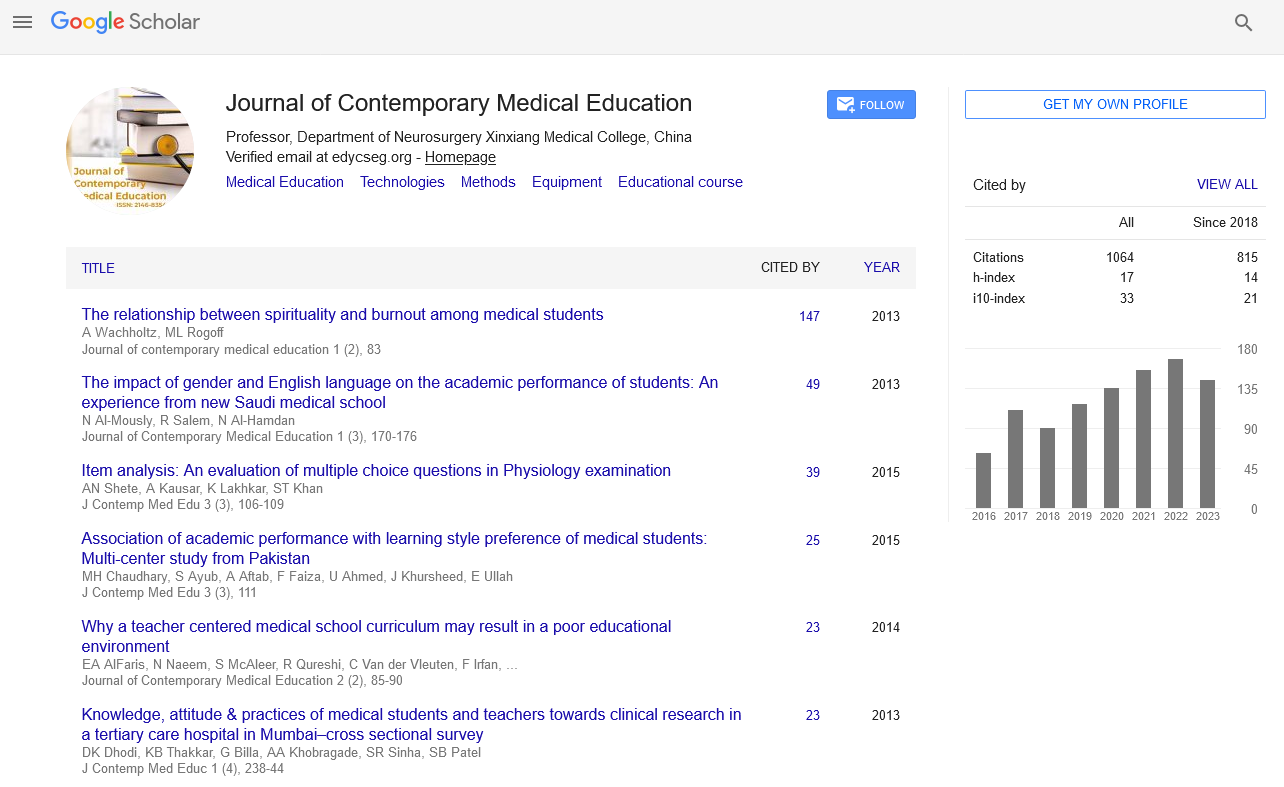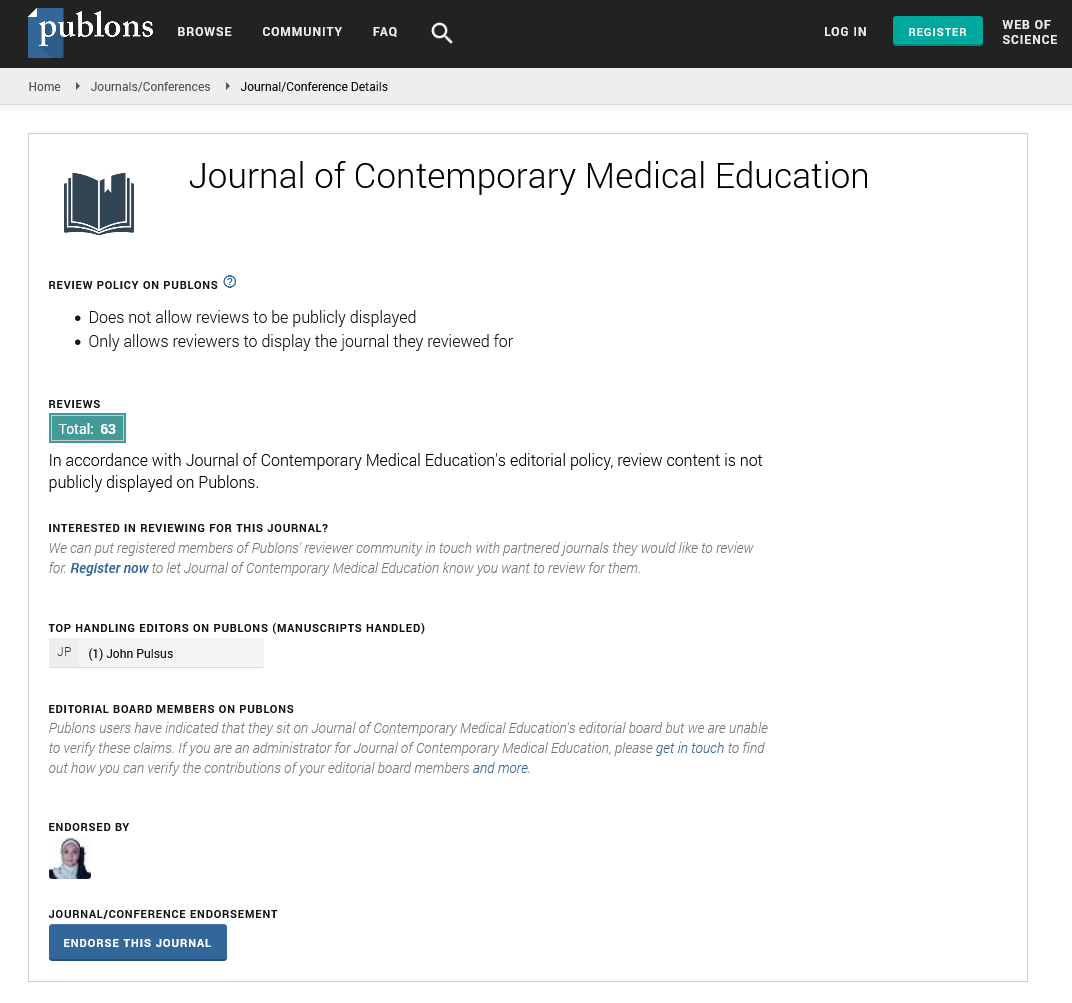Commentary - Journal of Contemporary Medical Education (2024)
Addressing Nutritional Diseases: Causes, Effects and Strategies for Effective Management
Samir Khan*Samir Khan, Department of Medicine, University of Chicago, Chicago, USA, Email: Samirkhan@gmail.com
Received: 05-Feb-2024, Manuscript No. JCMEDU-24-131619; Editor assigned: 08-Feb-2024, Pre QC No. JCMEDU-24-131619 (PQ); Reviewed: 22-Feb-2024, QC No. JCMEDU-24-131619; Revised: 29-Feb-2024, Manuscript No. JCMEDU-24-131619 (R); Published: 07-Mar-2024
Description
Nutritional diseases, also known as malnutrition- related diseases, result from inadequate intake, absorption, or utilization of essential nutrients. These conditions can have profound effects on physical and cognitive health, leading to a range of symptoms and complications. Despite significant advancements in food production and distribution, malnutrition remains a global health challenge, affecting individuals of all ages and socioeconomic backgrounds. This study discusses about the landscape of nutritional diseases, examining their causes, effects, diagnostic approaches and management strategies.
Types of nutritional diseases
Nutritional diseases can be broadly categorized into two types, they are undernutrition and overnutrition.
Undernutrition: Undernutrition occurs when individuals consume insufficient quantities of essential nutrients, leading to deficiencies in energy, protein, vitamins, and minerals.
Overnutrition: Overnutrition occurs when individuals consume excess calories, often accompanied by imbalances in macronutrients and micronutrients. Overnutrition is a leading cause of obesity and diet-related chronic diseases.
Effects of nutritional diseases
Nutritional diseases can have profound effects on physical health, growth, development, and overall well-being. Depending on the type and severity of malnutrition, individuals may experience a range of symptoms and complications including:
Growth retardation: Chronic undernutrition in childhood can lead to stunted growth, delayed development, and cognitive impairments.
Immune dysfunction: Malnutrition weakens the immune system, increasing susceptibility to infections and infectious diseases such as pneumonia, diarrhea, and tuberculosis.
Anemia: Iron deficiency anemia is a common consequence of undernutrition, leading to fatigue, weakness, pale skin, and impaired oxygen transport.
Neurological disorders: Micronutrient deficiencies, particularly vitamin B12 and folate deficiencies, can cause neurological problems such as neuropathy, cognitive decline, and developmental delays.
Diagnosis and assessment
Diagnosing nutritional diseases requires a comprehensive assessment of dietary intake, anthropometric measurements, clinical signs and symptoms, biochemical markers, and functional indicators of nutritional status.
Dietary assessment: Evaluating dietary intake provides insight into nutrient adequacy, dietary patterns, and food preferences. Methods of dietary assessment include food diaries, 24-hour recalls, food frequency questionnaires, and dietary screening tools.
Anthropometric measurements: Anthropometric measurements such as height, weight, Body Mass Index (BMI) and Mid-Upper Arm Circumference (MUAC) are used to assess growth, nutritional status, and body composition. These measurements can help identify undernutrition (e.g., low BMI, stunting) or overnutrition (e.g., high BMI, central obesity).
Biochemical markers: Laboratory tests measuring serum or plasma levels of specific nutrients (e.g., iron, vitamin D, folate) can provide objective evidence of nutritional deficiencies or excesses.
Clinical signs and symptoms: Clinical examination may reveal physical signs of malnutrition, such as muscle wasting, edema, dermatitis, or hair changes, which can aid in diagnosis and assessment.
Functional indicators: Functional assessments of physical performance, cognitive function, and immune function can provide valuable information about the impact of malnutrition on overall health and wellbeing.
Management and treatment
The management of nutritional diseases aims to address underlying deficiencies or excesses, restore nutritional balance, and prevent complications. Treatment strategies may include:
Dietary counseling: Providing education and guidance on healthy eating habits, food choices, portion sizes, and meal planning can help individuals achieve and maintain optimal nutritional status.
Supplementation: In cases of specific micronutrient deficiencies, supplementation with vitamins, minerals, or fortified foods may be prescribed to correct deficiencies and prevent complications.
Nutritional support: For individuals with severe undernutrition or inability to consume adequate nutrients orally, nutritional support interventions such as oral nutritional supplements, enteral feeding, or parenteral nutrition may be necessary.
Lifestyle modification: Encouraging physical activity, promoting weight management, and addressing unhealthy behaviors such as smoking and excessive alcohol consumption are important components of managing overnutrition and obesity-related conditions.
Prevention and public health strategies
Preventing nutritional diseases requires a multi-faceted approach addressing social, economic, environmental, and behavioral determinants of health. Key strategies include:
Promoting healthy eating: Educating individuals and communities about the importance of balanced diets, diverse food choices, and breastfeeding practices can help prevent malnutrition and promote optimal growth and development.
Advocacy and policy development: Advocating for evidence-based nutrition policies, regulations, and interventions at the national and global levels can create supportive environments for healthy eating and prevent malnutrition-related morbidity and mortality. Nutritional diseases remain a significant public health challenge worldwide, affecting individuals of all ages and populations. Addressing the complex interplay of factors contributing to malnutrition requires comprehensive approaches spanning individual, community, and policy levels. By promoting healthy eating habits, improving food security, strengthening healthcare systems, and implementing evidence-based interventions, people can work towards preventing and alleviating the burden of nutritional diseases and improving the health and well-being of populations globally.







